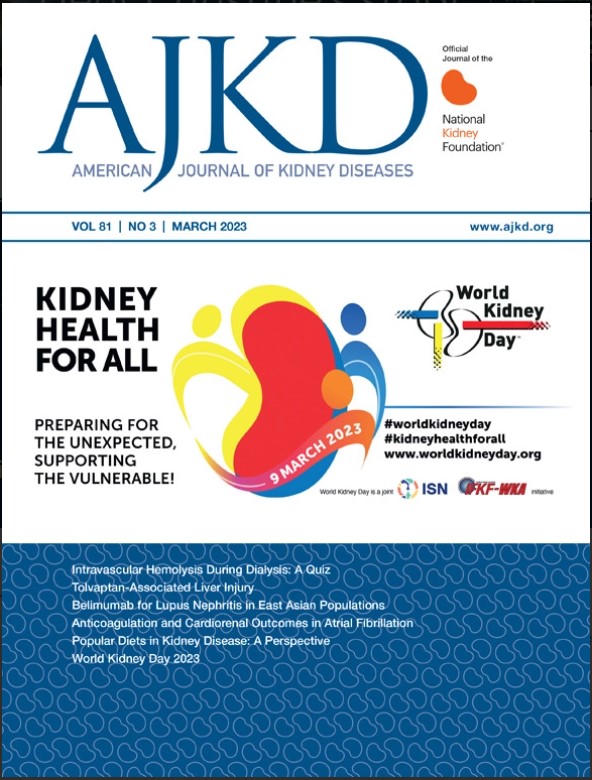Longitudinal Patterns of Ankle-Brachial Index and Their Association With Progression of CKD in Patients With Type 2 Diabetes and Elevated Body Mass Index
IF 8.2
1区 医学
Q1 UROLOGY & NEPHROLOGY
引用次数: 0
Abstract
Rationale & Objective
Ankle-brachial index (ABI) is used to screen for vascular complications in the setting of diabetes. This study sought to examine the relationship of longitudinal ABI data and chronic kidney disease (CKD) progression in patients with type 2 diabetes mellitus (T2DM) and increased body mass index.
Study Design
A post hoc analysis of the Look AHEAD (Action for Health in Diabetes) trial.
Setting & Participants
This study included 3,631 participants in the Look AHEAD trial with a baseline estimated glomerular filtration rate >60 mL/min/1.73 m2.
Exposures
Average ABI and average annual change in ABI were calculated based on annual ABI measurements during the first 4 years of the study.
Outcome
CKD progression, defined as kidney failure requiring maintenance dialysis or the occurrence of an estimated glomerular filtration rate <60 mL/min/1.73 m2 with a decrease of ≥30% versus baseline at a follow-up visit.
Analytical Approach
Restricted cubic spline and Cox proportional hazards models were fit to estimate associations and to explore nonlinearity.
Results
During a median follow-up of 10.1 years, CKD progression developed in 1,051 participants. There was a reversed J-shaped relationship of CKD progression with average ABI (ABI <1.17: HR per 1-SD decrement, 1.23; 95% CI, 1.06-1.42; ABI ≥1.17: HR per 1-SD increment, 1.10; 95% CI, 1.00-1.22) and average annual change in ABI (change in ABI less than −0.007: HR per 1-SD decrement, 1.37; 95% CI, 1.12-1.66; change in ABI of at least −0.007: HR per 1-SD increment, 1.13; 95% CI, 1.03-1.24).
Limitations
Observational study, potential unmeasured confounding.
Conclusions
Low and high-average ABI, even at clinically normal values, as well as decreasing and increasing average annual ABI, were associated with a higher risk of CKD progression in patients with T2DM and increased body mass index. Monitoring ABI and its changes over time may facilitate CKD risk stratification in patients with T2DM.
Plain-Language Summary
The ankle-brachial index (ABI) has recently become a routine screening parameter for vascular complications in patients with diabetes. In this post hoc analysis of the Look AHEAD (Action for Health in Diabetes) trial including 3,631 participants with type 2 diabetes mellitus and increased body mass index, we examined the longitudinal relationship of average ABI and annual change in ABI with chronic kidney disease progression. We observed that low and high-average ABI, even at clinically normal values, as well as decreases and increases in average annual ABI, were associated with a higher risk of chronic kidney disease progression in patients with type 2 diabetes mellitus and increased body mass index.
2 型糖尿病患者踝肱指数的纵向模式及其与慢性肾脏病进展的关系
原理和目的:踝肱指数(ABI)用于筛查糖尿病患者的血管并发症。本研究旨在探讨纵向 ABI 数据与 2 型糖尿病(T2D)和体重指数(BMI)升高患者的慢性肾病(CKD)进展之间的关系:Look AHEAD试验的事后分析:这项研究包括 Look AHEAD 试验中基线肾小球滤过率 (eGFR) >60 ml/min/1.73 m2 的 3,631 名参与者:平均 ABI 和平均 ABI 年变化是根据研究前 4 年的年度 ABI 测量值计算得出的:CKD进展,定义为需要维持性透析的肾衰竭或随访时eGFR2相对于首次eGFR测量值下降≥30%:分析方法:采用限制性立方样条和考克斯比例危险模型来估计相关性并探讨非线性:在10.1年的中位随访期间,有1051名参与者出现了CKD进展。CKD进展与平均ABI呈反向J形关系(当ABI为限制性指标时):局限性:观察性研究,可能存在未测量的混杂因素:即使在临床正常值下,平均 ABI 值过低和过高,以及年平均 ABI 值下降和上升,都与 T2D 和体重指数升高患者的 CKD 进展风险较高有关。监测 ABI 及其随时间的变化有助于对 T2D 患者进行 CKD 风险分层。
本文章由计算机程序翻译,如有差异,请以英文原文为准。
求助全文
约1分钟内获得全文
求助全文
来源期刊

American Journal of Kidney Diseases
医学-泌尿学与肾脏学
CiteScore
20.40
自引率
2.30%
发文量
732
审稿时长
3-8 weeks
期刊介绍:
The American Journal of Kidney Diseases (AJKD), the National Kidney Foundation's official journal, is globally recognized for its leadership in clinical nephrology content. Monthly, AJKD publishes original investigations on kidney diseases, hypertension, dialysis therapies, and kidney transplantation. Rigorous peer-review, statistical scrutiny, and a structured format characterize the publication process. Each issue includes case reports unveiling new diseases and potential therapeutic strategies.
 求助内容:
求助内容: 应助结果提醒方式:
应助结果提醒方式:


